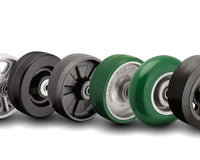Introduction:
In the bustling world of industrial manufacturing and material handling, the choice of casters can significantly impact efficiency, safety, and overall performance. Among the myriad options available, rubber and polyurethane casters stand out as popular choices for movement solutions. This blog post aims to provide a comprehensive comparison of rubber and polyurethane casters, highlighting their respective strengths and weaknesses.
Rubber Casters:
Rubber casters have long been a staple in industrial environments, prized for their cost-effectiveness and versatile performance. One of the key advantages of rubber is its ability to absorb shocks and vibrations, making it an ideal choice for applications where noise reduction and floor protection as well as preventing shock to the load being moved are paramount. Rubber casters are also known for their excellent traction, providing stability and ease of maneuverability in various working conditions. It is important to note that there have been many material and manufacturing advancements in “rubber wheels” over the past 30 years. Where the industry once utilized either a traditional hard or soft rubber wheel (depending on the load capacity and shock absorption desired), there are now hundreds of types of formulated rubber wheels—including very advanced injection molded wheels to the traditional compression molded rubber wheels comprised of premium virgin rubber materials to cheap and smelly reground rubber tires.
In terms of performance and workplace safety, rubber wheel caster advantages stem from their softer material properties, providing key benefits versus harder wheel materials such as metal, phenolic, or polypropylene (plastic). The ability of rubber to cushion shocks and vibrations plays a pivotal role in creating a more comfortable working environment. By minimizing the impact of bumps and irregularities on the floor, rubber casters contribute to smoother and less jarring movements, reducing the strain on both equipment and operators. This quality is particularly valuable in settings where noise reduction and floor protection coexist with the need for a user-friendly and comfortable workplace. Rubber wheels also are typically resistant to most chemicals and oils, allowing them to be a safe solution for a wide range of applications and environments.
However, it's crucial to acknowledge that there are limitations of rubber casters. While they excel in roles that require shock absorption and floor protection, traditional rubber wheels will wear out faster than their polyurethane counterparts, particularly in medium to heavy-duty applications. Rubber casters are also sensitive to extreme temperatures and may harden or crack over time when exposed to harsh environmental conditions. Chipping, cracking, and chunking are all realistic and expected forms of wear that happen in traditional rubber wheel casters, and often signal when it's time to replace the wheels on your asset or upgrade to a more performance-based wheel option. As previously mentioned though, there are many types of performance rubber wheel formulations, and some are designed to handle tough applications (think about your car tires!)–so if shock absorption quiet rolling, and floor protection are critical to you, contact us to make sure you are specifying the right rubber wheel for your application.
Polyurethane Casters:
Polyurethane wheel casters have gained popularity in industrial settings for their exceptional durability, ergonomic impact, and load-bearing capacity. These wheels boast a high abrasion resistance, are floor protective, and are resistant to chemicals and oils, making them suitable for demanding environments such as manufacturing plants and warehouses. Polyurethane is also more resistant to wheel flat spotting under heavier loads, ensuring a smoother and more ergonomic rolling operation compared to rubber in heavier applications.
Beyond their durability and load-bearing prowess, using polyurethane casters can contribute significantly to ergonomic considerations in most industrial settings. The low rolling resistance of polyurethane ensures a smoother and easier operation for equipment operators, reducing the effort required to move carts or equipment (especially when combined with precision ball bearings in the wheel). This characteristic not only enhances workplace ergonomics but also minimizes the risk of operator fatigue and strain. The ergonomic benefits of polyurethane casters make them an excellent choice for environments where the ease of maneuverability and employee well-being are top priorities.
Polyurethane wheel casters, much like rubber previously mentioned, have advanced significantly in their formulations and manufacturing processes over the last 30 years. From economical versions with a plastic core (found on many toolboxes) to advanced debris-shedding formulations on precision aluminum cores, there are many varieties of polyurethane now available. It can be manufactured to specific hardnesses and be very lively for maximum ergonomic value or be formulated to handle some of the heaviest loads possible.
While polyurethane casters boast impressive durability and load-bearing capabilities, it's essential to acknowledge their downsides in comparison to rubber casters. Polyurethane casters may have a higher initial cost, making them often less budget-friendly than their rubber counterparts. Depending on the polyurethane formulation and core material, you may also not achieve the same level of shock absorption, noise reduction, or floor protection when comparing them to performance-based rubber wheels. Additionally, while polyurethane excels in smooth and quiet operation, it may not provide the same level of traction as rubber on certain surfaces in lighter-duty applications.
Comparison:
When comparing rubber and polyurethane casters, it's essential to consider the specific needs of the industrial setting in which the application is being sought. Rubber excels in shock absorption and traction, making it suitable for environments where noise reduction and floor protection are crucial. On the other hand, polyurethane is the go-to choice for heavy-duty applications where durability, load-bearing capacity, and abrasion resistance are paramount.
In conclusion, the choice between rubber and polyurethane casters depends on the unique requirements of the industrial setting and the specifics of the common loads being transported. While rubber offers cost-effectiveness and excellent shock absorption, polyurethane provides superior durability and load-bearing capabilities. Ultimately, and especially in larger volume or higher capacity applications, a careful evaluation of the specific demands of the environment will guide the decision-making process, ensuring that the selected materials align with the goals for safety, efficiency, and performance.




